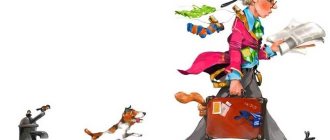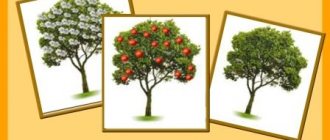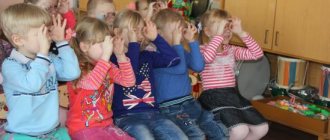Summary of a frontal lesson in a senior speech therapy group
Summary of the frontal lesson “Kolobok’s Journey” in the senior speech therapy group.
Summary of a speech therapy lesson aimed at developing the phonetic-phonemic aspect of speech in children using health-saving technologies
Author: Marina Alekseevna Durneva, teacher-speech therapist, MBDOU kindergarten No. 17, Kamensk-Shakhtinsky. Description: This lesson was conducted in a senior speech therapy group. When preparing the lesson, the emphasis was on the lexical topic “Autumn”. This lesson will be useful for speech therapists and preschool teachers. Goals and objectives: Correctional and educational:
• teach children to characterize the sounds [y] and [a], select words for a given sound.
• introduce children to the sound [p] and the way it is characterized based on articulatory and acoustic features; • introduce the concept of a “voiceless consonant” and the location of the sound at the beginning of a word; • learn to identify sounds in syllables and words. Correctional and developmental:
• develop general, fine and articulatory motor skills of children;
• develop phonemic processes; • develop breathing and voice; • consolidate the concepts: “sound”; • improve children's communication skills; • increase speech activity; • develop melodic-intonation and prosodic aspects of speech; • develop mental processes; • increase performance and endurance. Correctional-educational:
• to develop in children the ability to finish what they start, perseverance and the ability to handle handouts.
Equipment: pictures of fairy tale characters, leaves with pictures, a river, a bridge, counting sticks, pictures for articulation gymnastics, an illustration of the “Letter P,” a tape recorder, a board.
Progress of the lesson:
1. Organizational moment. Speech therapist: To be polite, you need to say hello to everyone you meet - children know this. You say hello, and in response, Children will say: Hello, hello! Speech therapist: Let's say hello to our guests (children say hello). Now let's say hello to each other. Logori (development of communication skills, initiative behavior, speed of reaction).
2. Main part. Teacher: Guess the riddle: I didn’t tremble before the wolf, I ran away from the bear, But I got caught in the fox’s teeth... (Kolobok) Let’s come up with our own fairy tale about Kolobok. Who will help us with this? (smart head) Then let's do some brain exercises. It will help you become attentive, active, relieve tension, fear, irritation and improve your achievements! Kinesiological exercises.
• “Ear – nose – cotton” - with your left hand, grab the tip of your nose, and with your right hand, grab the opposite ear. At the same time, release your ear and nose, clap your hands, change the position of your hands “exactly the opposite.” •“Fist – rib – palm.”
Who else will help us?
(tongue). Articulation gymnastics. Children perform exercises according to the text they heard and the picture they saw:
“We open our mouth - house, who is the boss in that house? The owner in it, the tongue, rested on his lip with a spatula (“Spatula”). The tongue goes out for a walk, it goes around the house (lick lips in a circle). Who is here and who is there? He looks around (“Watch”). He sees: the lips are very flexible, deftly stretching towards a smile (“Fence”), And now, on the contrary, the lips are stretching forward (“Elephant”). The tongue has become a painter, carefully painting the house (“Painter”). He found himself on a swing, flying up and going down (“Swing”). Who could guess? Our tongue is like a fungus! (“Fungus”) The tongue became an accordion, played and did not get tired (“Accordion”). Tired of transformations: Tongue licks jam (“Tasty Jam”). He loves to eat sweets, and then he gallops like a horse (“Horse”).
Well, now are you ready to come up with an interesting fairy tale?
Then let's begin. Grandma baked Kolobok. And now we’ll show you how she baked it. Finger gymnastics “Let’s bake a bun” - development of fine motor skills.
“Collecting flour from bottom to bottom” - children spread their fingers wide, then clench them into a fist.
“Knead the dough” - children move the fingers of one hand over the palm of the other clockwise, then change the position of their hands. “Roll out the dough” - rub your palm against your palm. “Make a Kolobok” - put palm on palm - “roll the ball.” Grandma baked Kolobok. I put it in the window to cool. The bun lay and lay. He jumped off the window and rolled (children perform the movement to the music). Logori (development of communication skills, initiative behavior, speed of reaction).
And there is a river on the way.
How do we get to the other side? Children offer answer options (swim across by boat, on a speedboat, on a ship). Speech therapist: You can walk across the bridge. But the bridge is not simple, this bridge is sound. The one who names words with the sound A or U will pass. Children name the words and walk across the bridge.
He crossed the river, sat down on a tree stump and sang (the children sing to the music): 1. I left my grandmother, I left my grandfather. This is the kind of bun I am, Kolobok is a ruddy side. 2. Oh, how good I am! How I love myself! I hug you tightly and inhale through my nose. Breathing exercise “Hug your shoulders” (according to A. N. Strelnikova).
Children stand straight and straight, their legs are slightly narrower. Than shoulder width apart; arms are bent at the elbows, raised to chest level and spread to the sides. In this case, one hand should be placed slightly lower. On the count of “one”, we hug ourselves so that the elbows are close to each other in one place, the arms form a triangle - inhale! After making 4 inhalation movements, you need to rest for a few seconds and perform this exercise again 4 times. And so 4 times, 4 inhalation movements.
A bunny runs past.
The Hare saw Kolobok and said: “Kolobok, Kolobok - I’ll eat you.” And Kolobok says: “Don’t eat me, let’s play instead.” The Hare thought and agreed. Game "Collect leaves".
Leaves are scattered around the room, children are spinning like leaves to the calm music. The music stops playing, everyone must take 1 leaf. There is a picture on the reverse side. Look at the picture and say the word. What is the first sound in this word? In all the words we encountered the sound “P”. Let's say it again and watch how we do it. Does the air come out easily or does it meet a barrier? What kind of barrier is this? (lips). So will the sound “P” be a vowel or a consonant? (consonant) Now put your hand on the neck and pronounce the sound “P”. Is the neck silent or trembling? (silent) So this sound is dull. And in writing this sound will be indicated by the letter “P” - showing the letter. Bunny says that he has instructions on how to make the letter “P” from sticks, but he won’t understand anything. Let's help him. The letter P is a doorway. We'll take three sticks. Let's fold the two into a straight path. We'll put the third one on top. Have you figured out how to make the letter “P” from sticks? Then go behind the tables and fold this letter for the bunny.
The hare thanks the children and leaves.
As soon as the hare ran away, the Wolf ran to meet Kolobok and said: “Kolobok, Kolobok - I’ll eat you.” And Kolobok says: “Don’t eat me, let me tell you what I learned about the sound “P.” The wolf thought and agreed. Children repeat the characteristics of the sound “P” - the sound “P” is consonant and unvoiced, denoted by the letter “P”. The Wolf was surprised by Kolobok’s knowledge and said: “Okay, I won’t eat you. But you have to play with me.” Game for the development of phonemic hearing “Clap-stomp”
The wolf thanks the children and leaves.
Only the Wolf ran away, the Bear goes to meet Kolobok and says: “Kolobok, Kolobok - I will eat you.” And Kolobok says: “Don’t eat me, let me tell you what I learned about the sound “P.” Children repeat the characteristics of the sound “P” - the sound “P” is consonant and unvoiced, denoted by the letter “P”. The Bear was surprised and said: You know about the sound “P”, but not everything. This sound can also be indicated by the color blue because it is a consonant. I won't eat you if you complete my task. Game "How many sounds?"
The speech therapist pronounces the syllables AP, UP. Children name sounds in syllables, characterize them and lay out diagrams.
The bear thanks the children and leaves.
As soon as the Bear has left, the Little Fox comes along. She saw Kolobok and said: “Kolobok, Kolobok - I’ll eat you.” And Kolobok says: “Don’t eat me, I’ll tell you a poem”: Pa-pa-pa - there is cereal on the table. Py-p-p-p - no cereal. Oop-op-op - everyone clap their hands. Whoop-whoop-whoop – Vanya’s soup is delicious. Yip-ip-ip - Philip came to us. Whoop-whoop-whoop – we ate the soup. The fox listened to the poem and said: Okay, I won’t eat you, but first let’s play a game. Pa-pa-pa, here comes the fox! Pa-pa-pa, so I’ll eat Kolobok! Py-poy-poy, and I’ll hide from the Fox! Pa-pa-pa, you won’t catch Kolobok! Children, standing in a circle, chant the words. In the center of the circle is the Fox, behind the circle is Kolobok. Having sung all the words, the children raise their clasped hands high up, making “collars.” And the Fox catches up with Kolobok, running after him around the circle. When the music ends, the game stops. Fox Kolobok didn’t catch him, got offended and ran away. Relaxation exercise “Kolobok is resting.”
Children sing the words of Kolobok: Children (sing): I was tired, I was in a hurry, I almost got lost. I’ll lie down in the clearing and look at the sky. If they lose, children lie down on the carpet and rest.
The teacher continues to sing himself: Hush, hush, don’t make noise, Don’t wake up the Kolobochki! The birds will begin to chirp, We will open our eyes, The children open their eyes and stand up. And now it’s time to say goodbye, Let’s say to everyone: “Goodbye! Bye!"
We recommend watching:
Summary of an individual educational activity with a 5-6-year-old pupil for the correction of sound pronunciation. Notes of an educational activity in a senior speech therapy group. Notes of a lesson in a senior speech therapy group. Notes of an individual correctional and developmental speech therapy lesson. Senior group
Similar articles:
Summary of educational activities in the older group of children with severe speech impairments on the topic: “Sounds S - Z”
Summary of educational activities in the senior group of children with severe speech impairments on the topic: “Sounds S - Sh”
Summary of a subgroup GCD to eliminate disturbances in sound pronunciation in children of the older group with severe speech impairments
Summary of educational activities in the senior speech therapy group on the topic “Cossacks and their traditions”
Logorhythmic lesson for children of senior preschool age with special needs on the topic: “What types of transport are there?”



